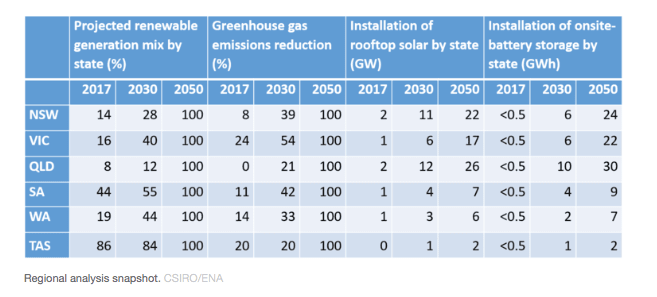The solar panel and battery revolution: how will your state measure up?
EXPERT OBSERVER![]()
A new roadmap for Australia’s electricity networks outlines a national plan to keep the lights on, make sure bills are affordable, and decarbonise our electricity industry by mid-century.
The plan, by CSIRO and Energy Networks Australia, sets out measures that could save households A$414 a year on average, by generating their own electricity through “distributed” technologies such as solar panels and batteries. It envisages that Australia could save a total of A$101 billion by 2050, while also bringing net greenhouse emissions to zero.
As described in an earlier draft report last December, Australia’s electricity networks can be transformed to give millions of customers more choice and control over their energy, while also meeting Australia’s international climate change commitments.
The roadmap calls for a coordinated approach, but how will that play out in practice?

Regional analysis
While it is a national plan, each state and territory will play its own distinct role.
Each faces different circumstances in terms of electricity demand growth, renewable resources, state renewable energy policies, and the age and fuel mix of their existing electricity infrastructure.
The full report outlines what each state and territory can expect.
New South Wales
The renewable electricity generation share in NSW is expected increase steadily to 28 percent by 2030. Thereafter, new generation capacity building is expected to accelerate to fill the gap left by more rapid coal capacity retirement.
NSW’s rooftop solar panel capacity will increase by more than 400 percent by 2030, with more than 6,000 megawatt hours in small-scale battery storage. These changes will be driven largely by falling costs, which will encourage wider customer adoption and the use of larger system sizes.
NSW customers will become a significant player in Australia’s overall energy system, with the capacity of the state’s rooftop solar panels projected to exceed 11,000MW by 2030 - more than the state’s coal-fired capacity today.
Queensland
Similarly to NSW, were the lack of coal plant retirement to be the main driver, Queensland’s renewable electricity share would lag other states at only 12% by 2030, with more rapid transformation occurring in the period between 2030 and 2050. However, state government renewable energy schemes could modify this outcome.
Queensland will see a huge increase in rooftop solar panels, of more than 500 percent by 2030. By then, it is also forecast to have more than 10,000MWh of small-scale battery storage capacity – the equivalent of 760,000 residential battery storage systems. That will rise to the equivalent of more than 2 million household battery systems by 2050.
High levels of rooftop solar and other distributed generation will create challenges for Queensland’s electricity network. There is the potential for “reverse flow” (where local generation exceeds consumption) in many parts of the Queensland power system within 15 years.
Victoria
Victoria is assumed to meet its target of 40 percent renewable share of generation by 2025 and maintain that share for next 15 years before investment accelerates again in the 2040s.
Victoria is also set for a 500% increase in rooftop solar panels by 2030, and more than 6,000MWh in small-scale battery storage. These batteries would represent the equivalent of 440,000 residential battery storage systems installed by 2030, and more than 1 million by 2050.
South Australia
South Australia has the second highest share of renewables of all states at around 40 percent and is expected to steadily improve that position until other states accelerate their own building programs in the 2030s.
South Australia’s rooftop solar panels will increase by more than 300 percent by 2030, with 4,000MWh of small-scale battery storage.
While South Australia already leads the nation in the installation of new large-scale renewable generation and is set to become a leading installer of large-scale battery capacity, small-scale renewables and batteries will also play an important part in its future energy mix, as in other states.
SA will lead the way in large-scale solar installation, although rooftop solar is where the real nationwide growth will be. AAP Image/Lyon Solar
Western Australia
WA’s rooftop solar power capacity will triple by 2030, combined with a forecast 2,000MWh of small-scale battery storage.
More than 40 percent of the states’s electricity is projected to come from renewable sources by 2030, as is the case in South Australia today.
Tasmania
Tasmania is the leading renewable generation state and its hydro generation and storage capacity could support grid stability in the broader National Energy Market into the future.
Residential battery storage would play a small but significant role in supporting the energy transformation in Tasmania. More than 1,000MWh in onsite battery capacity could be installed in Tasmania by 2030, and more than 2,000MWh by 2050.
Paul Graham is chief economist, CSIRO energy, CSIRO and author for The Conversation. He can be contacted here.
